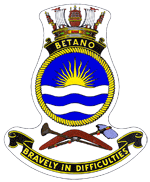Design and construction
The eight-vessel Balikpapan class was ordered as a locally manufactured replacement for the Australian Army's LSM-1-class landing ship medium and ALC 50 landing craft. [3] They are 44.5 metres (146 ft) long, with a beam of 10.1 metres (33 ft), and a draught of 1.9 metres (6 ft 3 in). [4] The landing craft have a standard displacement of 316 tons, with a full load displacement of 503 tons. [4] They are propelled by two G.M. Detroit 6-71 diesel motors, providing 675 brake horsepower to the two propeller shafts, allowing the vessels to reach 9 knots (17 km/h; 10 mph). [4] The standard ship's company is 13-strong. [4] The Balikpapans are equipped with a Decca RM 916 navigational radar, and fitted with two 7.62 millimetres (0.300 in) machine guns for self-defence. [4]
The LCHs have a maximum payload of 180 tons; equivalent to 3 Leopard 1 tanks, 13 M113 armoured personnel carriers, 23 quarter-tonne trucks, or four LARC-V amphibious cargo vehicles. [4] [5] As a troop transport, a Balikpapan-class vessel can transport up to 400 soldiers between a larger amphibious ship and the shore, or embark 60 soldiers [6] in six-berth caravans for longer voyages. [5] The vessel's payload affects the range: at 175 tons of cargo, each vessel has a range of 1,300 nautical miles (2,400 km; 1,500 mi), which increases to 2,280 nautical miles (4,220 km; 2,620 mi) with a 150-ton payload, and 3,000 nautical miles (5,600 km; 3,500 mi) when unladen. [4] The flat, box-like keel causes the ships to roll considerably in other-than-calm conditions, limiting their ability to make long voyages. [5]
Betano was laid down by Walkers Limited at Maryborough, Queensland on 3 October 1972, launched on 12 December 1972, and commissioned into the RAN on 8 February 1974. [7]
Operational history
In April 1974, Betano, Buna, and Brunei transited to Lord Howe Island as a demonstration of the Balikpanan class' oceangoing capabilities. [8]
Following the destruction of Darwin by Cyclone Tracy during the night of 24–25 December 1974, Betano was deployed as part of the relief effort; Operation Navy Help Darwin. [9] Betano sailed from Brisbane on 26 December. [9]
From 1985 to 1988, Betano and Brunei were assigned to the Australian Hydrographic Officer and operated as survey ships in the waters of northern Australia and Papua New Guinea. [8]
The ship was deployed to East Timor as part of the Australian-led INTERFET peacekeeping taskforce from 19 January to 19 February 2000. [10] Her service earned her the battle honour "East Timor 2000". [1] [2]
This page is based on this
Wikipedia article Text is available under the
CC BY-SA 4.0 license; additional terms may apply.
Images, videos and audio are available under their respective licenses.

